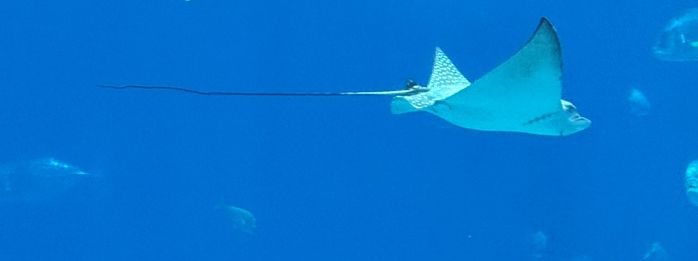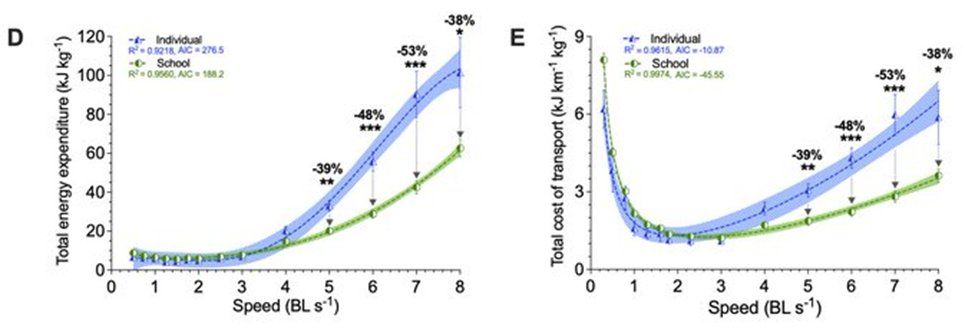Not yet, but the keels of carangids are very interesting too!
5. We hypothesize that tuna keels with their dorsal and ventral tubules act as flow sensors, perhaps providing information on tail beat frequency, amplitude, force, and water flow dynamics over the caudal region of the tuna body during locomotion.
4. The keel lateral line canal (pink color) is quite strange: neuromasts are surrounded by modified scales (shown in blue), and keels have an odd set of elongated skeletal elements posteriorly. Tuna keels are clearly mechanosensory.
3. Now, a team led by @juliachaumel.bsky.social and published in iScience @cp-iscience.bsky.social shows that tuna keels have a sensory function too! Each keel has a peculiar lateral line canal with small tubules that extend to the upper and lower keel surfaces (www.cell.com/iscience/ful...
2. And here’s a view of the caudal fin and keels from behind during #tuna locomotion. Our previous work has shown that the keels decrease power requirements during swimming, likely by reducing lateral forces and yaw torques. But wait, there's more!
1. #Tuna have well-developed bilateral keels extending to the right and left sides at the caudal peduncle area just in front of the tail. This movie shows the keel area during locomotion in yellowfin tuna. What is the function of keels in #tuna? A🧵 and new hypothesis.
Reposted by George Lauder
Our new paper is out as OA! shorturl.at/BueUy
Tuna keels aren't just for hydrodynamics—they're mechanosensory! 🐟 They contain a modified lateral line, possibly adapted to detect stimuli in high-noise environments
@georgelauder.bsky.social @jackiew8.bsky.social + Dylan Wainwright + Connor White
Tuna keels aren't just for hydrodynamics—they're mechanosensory! 🐟 They contain a modified lateral line, possibly adapted to detect stimuli in high-noise environments
@georgelauder.bsky.social @jackiew8.bsky.social + Dylan Wainwright + Connor White

Thanks, yes. The tail is an amazing sensory structure, but nobody has looked before!
And the @nytimes.com has a nice summary of our work here shorturl.at/onRkL written by @jack-tamisiea.bsky.social.

Scientists Finally Make Heads of Giant Stingray Tails
The long structures seen in manta rays and their relatives function as an early warning system, rather than a defensive weapon.
shorturl.at
We propose that the ray tail acts like a “hydrodynamic antenna” providing detailed information to the ray on water movement behind the body. This video shows the effect of moving water near the tail of a cownose ray as it passes by.
There are paired lateral line canals along both sides of the entire length of the tail with a remarkable branched structure that ends at the tail surface with clusters of pores. Each canal has a continuous neuromast that extends the entire tail length!
What is the function of the elongate tail in elasmobranch #rays? A 🧵 and a new hypothesis. A paper with @juliachaumel.bsky.social in @royalsociety.org Proceedings B (shorturl.at/PmfYD) shows that the tail of cownose rays (and a few other species studied so far) has an elaborate lateral line.

What is the significance of the tremendous diversity of #shark skin #denticles? Presenting our experimental approach to understanding this at the Atlanta #SICB2025 meetings. Come to the session for all things shark skin!
Thanks Valentina! The manuscript should be out soon ... we're waiting for proofs now.
Overall this supports the new “turbulence sheltering hypothesis” for why fish might group together, especially during active migratory movements where water flow is chaotic and turbulent: fish in a school can save a considerable amount of energy compared to swimming alone.
This occurs largely because individuals within the school alter the flow environment with their undulating bodies and proximity: fish within schools in turbulence swim more closely together as speed increases compared to schools in laminar flow:

We showed that swimming in turbulence by fish schools dramatically reduces both the cost of swimming (orange curve, left panel, compared to purple curve), and the cost of transport (right panel) when in turbulence compared to individuals swimming alone.

@TheYangfanZHANG led the project with @mcalicc7, @HungtangK, and Prof. Rui Ni @JohnsHopkins to test this hypothesis, comparing individuals swimming alone to energy use by small schools swimming in turbulent conditions: paper at https://tinyurl.com/yc764d74
Collective movement of schooling fish reduces the costs o...
What are the benefits of collective behavior? This study ...
tinyurl.com
Most studies of fish schooling have involved swimming in still or slowly flowing water. But fish in groups often move through turbulent water conditions. Could swimming collectively act to mitigate the increased energy needed to swim in turbulence?
A new idea: the “turbulence sheltering hypothesis”. Fish in a school could modulate surrounding turbulence so that chaotic fluid motion increasing swimming cost is less. Fish in a group would use less energy compared to swimming alone in turbulent conditions.

Why do #fish swim in #schools? A🧵and new hypothesis. Schooling could help fish avoid predators, navigate, communicate, find mates and food, and save energy. Here we propose and test a new hypothesis: https://tinyurl.com/yc764d74
There are a wide variety of hydrodynamic mechanisms that allow energy savings as fish swim near each other and in each others wake, and fish in schools are changing relative positions dynamically through time.

Our results also cast doubt on using only simple kinematic metrics such as tail beat frequency as a proxy for energy savings: fish in schools can save energy even when tail beat frequency does not change.
We also showed that schooling fishes saved relatively more energy as they moved faster compared to solitary fish, and that the cost of transport curve is also U-shaped with clear benefits to swimming in a group.

By swimming both schools and solitary fish over a wide range of speeds, we showed that (1) very low speed swimming involves as much energy use as swimming at 3 body lengths/sec, and that the metabolism-speed curve is U-shaped over this speed range.

And, we need to study school and solitary swimming over a range of speeds and measure energy use both during swimming and during post-exercise recovery to quantify EPOC: the energy used to sustain swimming at high speeds beyond the aerobic threshold.

Do #fish swimming in a #school actually save energy? A🧵on this as our paper in @eLife https://elifesciences.org/articles/90352 by @TheYangfanZHANG addresses this question. This is a challenging issue to study: energy use by a school should be compared to solitary locomotion
Do #fish swimming in a #school actually save energy? Our paper on this in eLife elifesciences.org/articles/90352 addresses this question. This is a challenging issue: energy use by a school needs to be compared to solitary locomotion on a per gram basis under the same swimming conditions.

The shark #denticle #multiverse will be on display at #sicb2024 this week. See talks in the
@SICB_DCB_DVM
sessions. So much diversity, so little time ... below the #ontogeny of sleeper shark denticles from Vaz et al. 2023: mdpi.com/1424-2818/15...
@SICB_DCB_DVM
sessions. So much diversity, so little time ... below the #ontogeny of sleeper shark denticles from Vaz et al. 2023: mdpi.com/1424-2818/15...

The shark #denticle #multiverse will be on display at #sicb2024 this week. See talks in the @SICB_DCB_DVM sessions. So much diversity, so little time ... below the #ontogeny of sleeper shark denticles from Vaz et al. 2023: https://www.mdpi.com/1424-2818/15/11/1105

